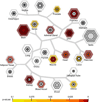Phenotypically anchored transcriptome profiling of developmental exposure to the antimicrobial agent, triclosan, reveals hepatotoxicity in embryonic zebrafish
- PMID: 27538710
- PMCID: PMC5023494
- DOI: 10.1016/j.taap.2016.08.013
Phenotypically anchored transcriptome profiling of developmental exposure to the antimicrobial agent, triclosan, reveals hepatotoxicity in embryonic zebrafish
Abstract
Triclosan (TCS) is an antimicrobial agent commonly found in a variety of personal care products and cosmetics. TCS readily enters the environment through wastewater and is detected in human plasma, urine, and breast milk due to its widespread use. Studies have implicated TCS as a disruptor of thyroid and estrogen signaling; therefore, research examining the developmental effects of TCS is warranted. In this study, we used embryonic zebrafish to investigate the developmental toxicity and potential mechanism of action of TCS. Embryos were exposed to graded concentrations of TCS from 6 to 120hours post-fertilization (hpf) and the concentration where 80% of the animals had mortality or morbidity at 120hpf (EC80) was calculated. Transcriptomic profiling was conducted on embryos exposed to the EC80 (7.37μM). We identified a total of 922 significant differentially expressed transcripts (FDR adjusted P-value≤0.05; fold change ≥2). Pathway and gene ontology enrichment analyses identified biological networks and transcriptional hubs involving normal liver functioning, suggesting TCS may be hepatotoxic in zebrafish. Tissue-specific gene enrichment analysis further supported the role of the liver as a target organ for TCS toxicity. We also examined the in vitro bioactivity profile of TCS reported by the ToxCast screening program. TCS had a diverse bioactivity profile and was a hit in 217 of the 385 assay endpoints we identified. We observed similarities in gene expression and hepatic steatosis assays; however, hit data for TCS were more concordant with the hypothesized CAR/PXR activity of TCS from rodent and human in vitro studies.
Keywords: Hepatotoxicity; Phenotypic anchoring; ToxCast; Transcriptomics; Triclosan; Zebrafish.
Copyright © 2016 Elsevier Inc. All rights reserved.
Conflict of interest statement
The authors have no conflicts of interest to declare.
Figures






Similar articles
-
Gene expression profiles in brain of male juvenile zebrafish (Danio rerio) treated with triclosan.Toxicol Appl Pharmacol. 2019 Jan 1;362:35-42. doi: 10.1016/j.taap.2018.10.014. Epub 2018 Oct 16. Toxicol Appl Pharmacol. 2019. PMID: 30336175
-
Triclosan affects axon formation in the neural development stages of zebrafish embryos (Danio rerio).Environ Pollut. 2018 May;236:304-312. doi: 10.1016/j.envpol.2017.12.110. Epub 2018 Feb 2. Environ Pollut. 2018. PMID: 29414352
-
Effects of prenatal exposure to triclosan on the liver transcriptome in chicken embryos.Toxicol Appl Pharmacol. 2018 May 15;347:23-32. doi: 10.1016/j.taap.2018.03.026. Epub 2018 Mar 27. Toxicol Appl Pharmacol. 2018. PMID: 29596926
-
Is Triclosan a neurotoxic agent?J Toxicol Environ Health B Crit Rev. 2017;20(2):104-117. doi: 10.1080/10937404.2017.1281181. Epub 2017 Feb 22. J Toxicol Environ Health B Crit Rev. 2017. PMID: 28339349 Review.
-
Triclosan: environmental exposure, toxicity and mechanisms of action.J Appl Toxicol. 2011 May;31(4):285-311. doi: 10.1002/jat.1660. J Appl Toxicol. 2011. PMID: 21462230 Review.
Cited by
-
A Short Review of the Toxicity of Dentifrices-Zebrafish Model as a Useful Tool in Ecotoxicological Studies.Int J Mol Sci. 2023 Sep 20;24(18):14339. doi: 10.3390/ijms241814339. Int J Mol Sci. 2023. PMID: 37762640 Free PMC article. Review.
-
Mechanistic Investigations Into the Developmental Toxicity of Nitrated and Heterocyclic PAHs.Toxicol Sci. 2017 May 1;157(1):246-259. doi: 10.1093/toxsci/kfx035. Toxicol Sci. 2017. PMID: 28186253 Free PMC article.
-
Comparison of Transcriptomics Changes Induced by TCS and MTCS Exposure in Human Hepatoma HepG2 Cells.ACS Omega. 2020 May 6;5(19):10715-10724. doi: 10.1021/acsomega.0c00075. eCollection 2020 May 19. ACS Omega. 2020. PMID: 32455190 Free PMC article.
-
Industrial, Biocide, and Cosmetic Chemical Inducers of Cholestasis.Chem Res Toxicol. 2019 Jul 15;32(7):1327-1334. doi: 10.1021/acs.chemrestox.9b00148. Epub 2019 Jun 18. Chem Res Toxicol. 2019. PMID: 31243985 Free PMC article.
-
Transcriptomic and phenotypic profiling in developing zebrafish exposed to thyroid hormone receptor agonists.Reprod Toxicol. 2018 Apr;77:80-93. doi: 10.1016/j.reprotox.2018.02.006. Epub 2018 Feb 16. Reprod Toxicol. 2018. PMID: 29458080 Free PMC article.
References
-
- Ahn KC, Zhao B, Chen J, Cherednichenko G, Sanmarti E, Denison MS, Lasley B, Pessah IN, Kultz D, Chang DP, Gee SJ, Hammock BD. In vitro biologic activities of the antimicrobials triclocarban, its analogs, and triclosan in bioassay screens: receptor-based bioassay screens. Environ Health Perspect. 2008;116:1203–1210. - PMC - PubMed
-
- Allmyr M, Adolfsson-Erici M, McLachlan MS, Sandborgh-Englund G. Triclosan in plasma and milk from Swedish nursing mothers and their exposure via personal care products. Sci Total Environ. 2006;372:87–93. - PubMed
-
- Andrade NA, Lozano N, McConnell LL, Torrents A, Rice CP, Ramirez M. Long-term trends of PBDEs, triclosan, and triclocarban in biosolids from a wastewater treatment plant in the Mid-Atlantic region of the US. J Hazard Mater. 2015;282:68–74. - PubMed
-
- Arbuckle TE, Weiss L, Fisher M, Hauser R, Dumas P, Berube R, Neisa A, LeBlanc A, Lang C, Ayotte P, Walker M, Feeley M, Koniecki D, Tawagi G. Maternal and infant exposure to environmental phenols as measured in multiple biological matrices. Sci Total Environ. 2015;508:575–584. - PubMed
-
- Axelstad M, Boberg J, Vinggaard AM, Christiansen S, Hass U. Triclosan exposure reduces thyroxine levels in pregnant and lactating rat dams and in directly exposed offspring. Food Chem Toxicol. 2013;59:534–540. - PubMed
Publication types
MeSH terms
Substances
Grants and funding
LinkOut - more resources
Full Text Sources
Other Literature Sources
Molecular Biology Databases

